Category: 2nd Grade
- Home
- /
- Shop
- /
- By Subject
- /
- Math
- /
- Curriculum & Textbooks
- /
- 2nd Grade
Showing 1–20 of 24 resultsSorted by latest
-
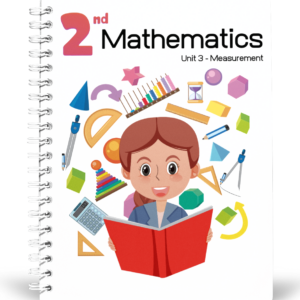 $5.00Buy Now
$5.00Buy NowThis unit introduces students to standard units of lengths in the metric and customary systems: centimeters, meter, inches, and feet. They examine how different measuring tools represent length units, learn how to use the tools, and gain experience in measuring and estimating the lengths of objects. Along the way, students notice that the length of the same object can be described with different measurements and relate this to differences in the size of the unit used to measure. Throughout the unit, students solve one- and two-step story problems involving addition and subtraction of lengths. To make sense of and solve these problems, they use previously learned strategies for adding and subtracting within 100, including strategies based on place value. To close the unit, students learn that line plots can be used to represent numerical data. They create and interpret line plots that show measurement data and use them to answer questions about the data. Students relate the structure of a line plot to the tools they used to measure lengths. This prepares students for the work in the next unit, where they interpret numbers on the number line as lengths from 0. The number line is an essential representation that will be used in future grades and throughout students’ mathematical experiences.
Includes: Student and Teacher Editions
Size: 372 pages -
Sale!
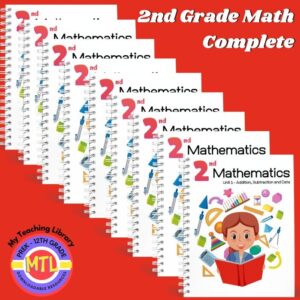 Buy Now
Buy Now$45.00Original price was: $45.00.$35.00Current price is: $35.00.2nd Grade Math Complete is a 9 unit program that covers all of the important skills and concepts typically covered in 2nd grade. Each unit includes the student and teacher edition. This resource can be used within a classroom setting, co-op or with individual students. Because it can be used within a group setting, you’ll find many activities for students to complete in pairs of 2. If you are homeschooling multiple children close in age, it would be easy to adapt and teach students together. If you are homeschooling a single child, you can easily adapt these activities through your one-on-one interaction!
You do not need to use the entire program if you are only wanting to focus on one or a few specific Math skills and concepts. If this is the case, you can purchase each unit separately.
Units:
- – Unit 1: Adding & Subtracting + Working with Data
- – Unit 2: Adding & Subtracting within 100
- – Unit 3: Measuring (Length)
- – Unit 4: Working with Number Lines
- – Unit 5: Working with Numbers to 1,000
- – Unit 6: Shapes, Time and Money
- – Unit 7: Adding & Subtracting to 1,000
- – Unit 8: Arrays: Even/Odd, Geometry & Multiplication Readiness
- – Unit 9: Review: 2nd Grade Level Skills & Concepts
-
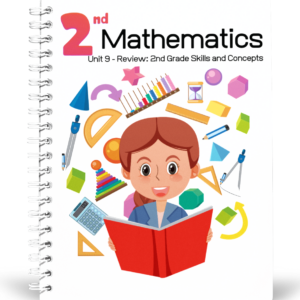 $4.50Buy Now
$4.50Buy NowIn this unit, students revisit major work and fluency goals of the grade, applying their learning from the year. Section A gives students a chance to solidify their fluency with addition and subtraction within 20. In section B, students apply methods they used with smaller numbers to add and subtract numbers within 100. In the final section, students interpret, solve, and write story problems involving numbers within 100, which further develop their fluency with addition and subtraction of two-digit numbers. They work with all problem types with the unknown in all positions.
Includes: Student and Teacher Editions
Size: 233 pages -
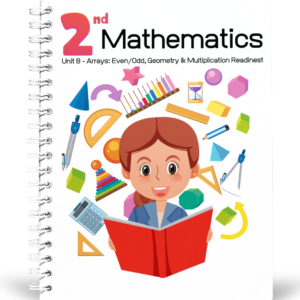 $5.00Buy Now
$5.00Buy NowIn this unit, students develop an understanding of equal groups, building on their experiences with skip-counting and with finding the sums of equal addends. The work here serves as the foundation for multiplication and division in grade 3 and beyond. Students begin by analyzing even and odd numbers of objects. They learn that any even number can be split into 2 equal groups or into groups of 2, with no objects left over. Students use visual patterns to identify whether numbers of objects are even or odd. Next, students learn about rectangular arrays. They describe arrays using mathematical terms (rows and columns). Students see the total number of objects as a sum of the objects in each row and as a sum of the objects in each column, which they express by writing equations with equal addends. They also recognize that there are many ways of seeing the equal groups in an array. Later, students transition from working with arrays containing discrete objects to equal-size squares within a rectangle. They build rectangular arrays using inch tiles and partition rectangles into rows and columns of equal-size squares. The work here sets the stage for the concept of area in grade 3.
Includes: Student and Teacher Editions
Size: 263 -
 $5.00Buy Now
$5.00Buy NowIn this unit, students extend their knowledge of the units in the base-ten system to include hundreds. They learn that a hundred is a unit made up of 10 tens, and three-digit numbers are formed using units of hundreds, tens, and ones. To make sense of numbers in different ways and to build flexibility in reasoning with them, students work with a variety of representations: base-ten blocks, base-ten diagrams or drawings, number lines, expressions, and equations. At the start of the unit, students express a quantity in terms of the number of units represented by base-ten blocks. Next, students make sense of three-digit numbers on the number line.
Includes: Student and Teacher Editions
Size: 287 -
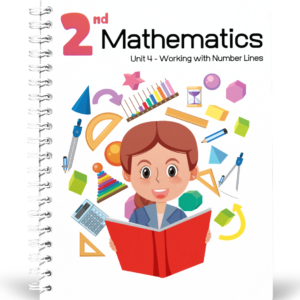 $5.00Buy Now
$5.00Buy NowIn this unit, students are introduced to the number line, an essential representation that will be used throughout students’ K–12 mathematical experience. They learn to use the number line to represent whole numbers, sums, and differences. They see that the tick marks and numbers on the number line are like those on a ruler: both show equally spaced numbers that represent lengths from 0. Students use this understanding of structure to locate and compare numbers on the number line, as well as to estimate numbers represented by points on the number line. Students then learn conventions for representing addition and subtraction on the number line: using arrows pointing to the right for adding and arrows pointing to the left for subtracting. Students also use the number line to represent addition and subtraction methods discussed in Number Talks, such as counting on, counting back by place, and decomposing a number to get to a ten. The reasoning here deepens students’ understanding of the relationship between addition and subtraction.
Includes: Student and Teacher Editions
Size: 309 -
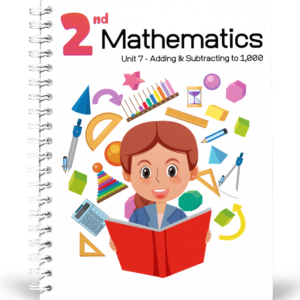 $5.00Buy Now
$5.00Buy NowIn this unit, students add and subtract within 1,000, with and without composing and decomposing a base-ten unit. They apply the methods they know and their understanding of place value and three-digit numbers to find sums and differences within 1,000. Initially, students add and subtract without composing or decomposing a ten or hundred. Instead, they rely on methods based on the relationship between addition and subtraction and the properties of operations. They make sense of sums and differences using counting sequences, number relationships, and representations (number line, base-ten blocks, base-ten diagrams, and equations). As the unit progresses, students work with numbers that prompt them to compose and decompose one or more units, eliciting strategies based on place value. Students learn to recognize when composition or decomposition is a useful strategy when adding or subtracting by place. In the later half of the unit, they encounter lessons that encourage them to think flexibly and use strategies that make sense to them based on number relationships, properties of operations, and the relationship between addition and subtraction.
Includes: Student and Teacher Editions
Size: 396 -
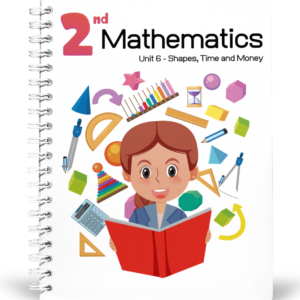 $6.00Buy Now
$6.00Buy NowIn this unit, students transition from place value and numbers to geometry, time, and money. They continue to look at attributes of a variety of shapes and see that shapes can be identified by the number of sides and vertices (corners). Students then study three-dimensional (solid) shapes, and identify the two-dimensional (flat) shapes that make up the faces of these solid shapes. Next, students look at ways to partition shapes and create equal shares. They extend their knowledge of halves and fourths (or quarters) from grade 1 to now include thirds. As they develop the language of fractions, students also recognize that a whole can be described as 2 halves, 3 thirds, or 4 fourths, and that equal-size pieces of the same whole need not have the same shape. Later, students use their understanding of halves and fourths (or quarters) to tell time. To continue to build fluency with addition and subtraction within 100, students conclude the unit with a money context.
Includes: Student and Teacher Editions
Size: 501 pages -
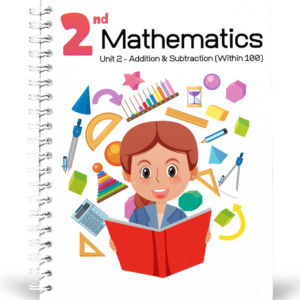 $5.00Buy Now
$5.00Buy NowIn this unit, students add and subtract within 100 using strategies based on place value, the properties of operations, and the relationship between addition and subtraction. Students begin by using any strategy to find the value of sums and differences that do not involve composing or decomposing a ten. They are then introduced to base-ten blocks as a tool to represent addition and subtraction and move towards strategies that involve composing and decomposing tens. Students develop their understanding of grouping by place value, and begin to subtract one- and two-digit numbers from two-digit numbers by decomposing a ten as needed. They apply properties of operations and practice reasoning flexibly as they arrange numbers to facilitate addition or subtraction. At the end of the unit, students apply their knowledge of addition and subtraction within 100 to solve one- and two-step story problems of all types, with unknowns in all positions. To support them in reasoning about place value when adding and subtracting, students may choose to use connecting cubes, base-ten blocks, tape diagrams, and other representations learned in earlier units and grades.
Includes: Student and Teacher Editions
Size: 336 pages -
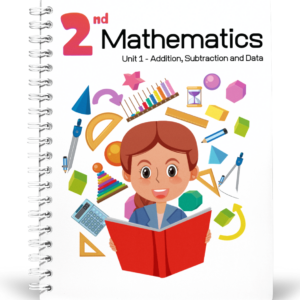 $5.00Buy Now
$5.00Buy NowIn this unit, students begin to develop (or review) fluency with sums and differences within 20, building on concepts of addition and subtraction that they covered while covering 1st grade skills and concepts. They learn new ways to represent and solve problems involving addition, subtraction, and categorical data. Students are introduced to picture graphs and bar graphs as a way to represent categorical data. They ask and answer questions about situations described by the data. The structure of the bar graphs paves the way for a new representation, the tape diagram. Students learn that tape diagrams can be used to represent and make sense of problems involving the comparison of two quantities. The diagrams also help to deepen students’ understanding of the relationship between addition and subtraction.
Includes: Student and Teacher Editions
Size: 376 pages -
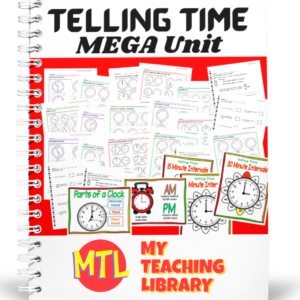 $5.25Buy Now
$5.25Buy NowTelling time is an important Math skill to learn in the 1st, 2nd and 3rd Grades. This math unit will give you everything you need to teach this skill! This resource includes:
– 5 Posters
– 84 Student Pages (See detailed description below)
– Answer Keys -
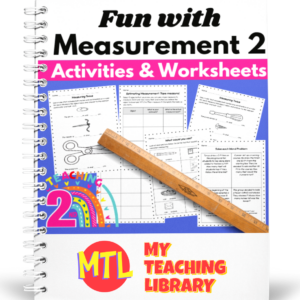 $2.50Buy Now
$2.50Buy NowHands-on activities and worksheets designed for 2nd grade students learning measurement skills such as using a variety of measurement tools (ruler, yardstick, meter stick and tape measure), finding two different measurements for objects (inches and centimeters), estimating measurements, and solving measurement word problems (with bonus if converting inches to feet and inches).
-
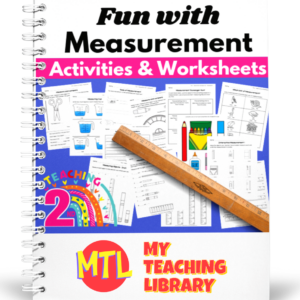 $3.50Buy Now
$3.50Buy NowHands-on activities and worksheets designed for students learning measurement skills such as:
- – Reading a ruler and using to measure objects (inches and centimeters)
- – Determining the best measurements (inches, feet, yards, miles / ounce, pounds / centimeter, meter, kilometer)
- – Tools of measurement
- – Reading a measuring cup
- – Comparing objects that have been measured
-
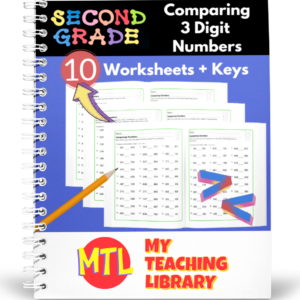 $1.75Buy Now
$1.75Buy NowThis set of no prep, 10 worksheets will give students the practice they need to compare three digit numbers. Students will be asked to use greater than, less than or an equal sign (<, > or =) for each pair of numbers. Each worksheet includes 30 number pairs to compare. Answer keys are included.
-
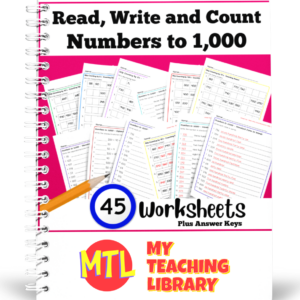 $3.50Buy Now
$3.50Buy NowThis resource will give students the opportunity to:
- – Display their understanding that the three digits of a three-digit number represent amounts of hundreds, tens, and ones; e.g., 706 equals 7 hundreds, 0 tens, and 6 ones by converting numbers to expanded form as well as full expanded form (numbers to 1000)
- – Show their ability to skip count by 5s, 10s, and 100s (numbers to 1000)
- – Read and write numbers to 1000 using base-ten numerals, number names, expanded form and full expanded form
This resource includes 45 worksheets plus answer keys:
- 5 Worksheets by 5s – Counting up
- 5 Worksheets by 5s – Counting down
- 5 Worksheets by 10s – Counting up
- 5 Worksheets by 10s – Counting down
- 3 Worksheets by 100s – Counting up
- 2 Worksheets by 100s – Counting both up and down
- 5 Worksheets – Given words to covert to standard form
- 5 Worksheets – Given standard form to covert to words
- 5 Worksheets – Given expanded form to covert to standard
- 5 Worksheets – Given standard form to convert to full expanded notation
-
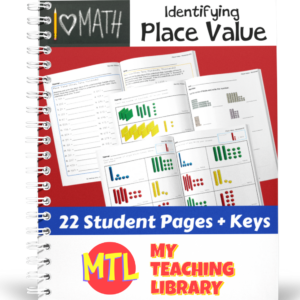 $3.25Buy Now
$3.25Buy NowHelp students learn to identify place value with this math resource! With 22 progressive student pages, students’ skill and understanding will increase.
The unit begins with students visually counting ‘ones’, then ‘tens’, then ‘hundreds’ using number blocks. Next, they proceed to identifying the place value of given numbers, beginning with 2 digit numbers (identifying ones and tens), then 3 digits (identifying ones, tens and hundreds) and finally 4 digits (identifying ones, tens, hundreds and thousands).
Perfect for use with multiple ages / grades or for differentiation. (Grades: 1st. 2nd and 3rd)
-
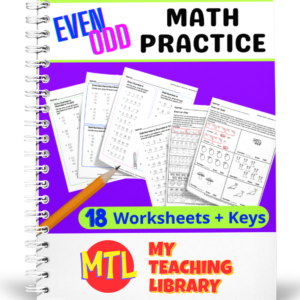 $3.00Buy Now
$3.00Buy NowGive students the practice they need to identify even and odd numbers! This resource includes 18 worksheets that progressively include higher numbers to really help students solidify their understanding.
Includes:
- – 4 worksheets (#’s to 20) w/ pictures: Students are to count and write how many, then create pairs (to determine if the number is even or odd) and then will circle even or odd.
- – 3 worksheets (#’s to 20) for students to identify odd numbers (given a sets of 6 numbers, they will circle every odd number)
- – 3 worksheets (#’s to 20) for students to identify even numbers (given a sets of 6 numbers, they will circle every even number)
- – 2 worksheets (#’s to 20) for students to identify both even and odd numbers (given a sets of 4 numbers, they will circle every even or odd number based on instructions given)
- – 4 worksheets (#’s to 50) for students to identify both even and odd numbers (given a sets of 4 numbers, they will circle every even or odd number based on instructions given)
- – 2 worksheets (#’s to 120) for students to identify both even and odd numbers (given a sets of 3 numbers, they will circle every even or odd number based on instructions given)
- – Answer Keys
Although 2nd grade skills require that students can identify even and odd numbers through 20, it is easy for them to go beyond twenty using this resource and the concepts they learn! Perfect to pair with Math Posters | Even – Odd Numbers
- – 4 worksheets (#’s to 20) w/ pictures: Students are to count and write how many, then create pairs (to determine if the number is even or odd) and then will circle even or odd.
-
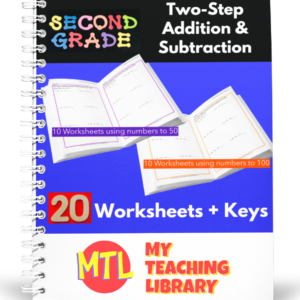 $3.25Buy Now
$3.25Buy NowGive students the practice they need to solve two-step addition and subtraction problems with these worksheets! Includes 20 worksheets plus answer keys in all. Here is what is included:
- – 10 two-step addition and subtraction problems using numbers up to 50
- – 10 two-step addition and subtraction problems using numbers up to 100
- – Answer keys
Each worksheet has 6 problems for students to solve plus asks students to show their work. They can use drawings and/or equations to explain their reasoning and understanding.
-
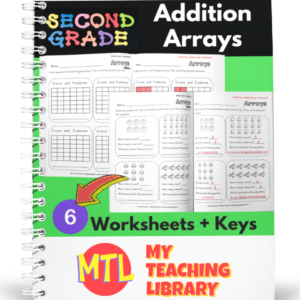 $2.25Buy Now
$2.25Buy NowAn array is a group of objects arranged in rows and columns. We can use arrays to show repeated addition! This resource provides 6 worksheets for students to practice repeated addition through math arrays. Includes answer keys.
Add these posters to your study: Math Posters | Addition Arrays
-
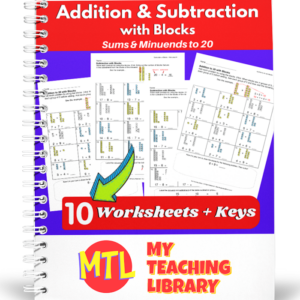 $2.25Buy Now
$2.25Buy NowTen worksheets for students to practice adding and subtracting using visual blocks (with sums and minuends to 20).
Includes:
- – 5 addition worksheets each including 12 problems to solve with visual blocks plus one addition problem for students to solve without blocks. For this final problem, students are asked to draw blocks to show their understanding.
- – 5 subtraction worksheets each including 12 problems to solve with visual blocks plus one subtraction problem where students are to label the minuend and the subtrahend.
- – Answer keys

